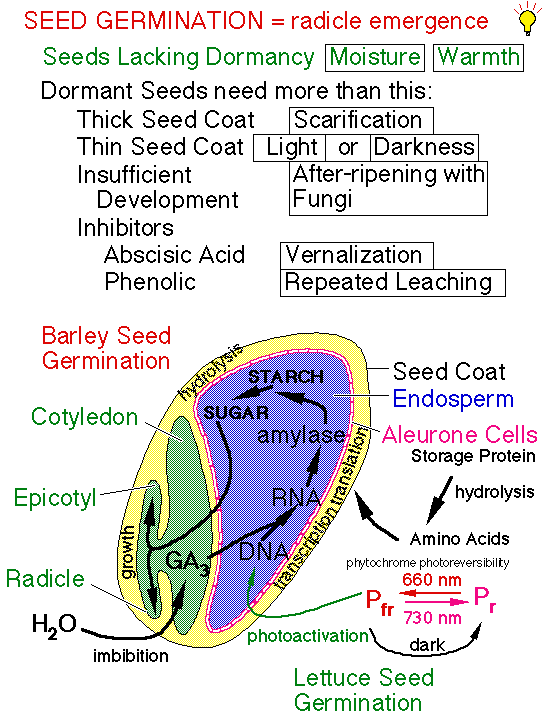
Keep in mind that the ovule in the ovary is what becomes the seed. The integument of the ovule becomes the seed coat. Inside the integument of the ovule was the embryo sac. The antipodals and synergids senesce and disintegrate. The central cell united with one sperm cell to make endosperm...a nutritive tissue that accumulates starch, protein, and fats to provide for the growth of the embryo. The egg cell of the embryo sac united with the other sperm cell to make a zygote. The zygote grows and becomes a true embryo inside the integument.
When you have a Dormant Embryo, a Storage Tissue, and a Seed Coat, then you have a SEED. In some seeds, the endosperm is retained as the storage tissue. In other seeds the endosperm is more or less used up to put storage chemicals into the embryo itself (commonly in the cotyledons). Below are diagrams and a photo of some seeds.


The seeds are carried inside the fruit by animals called dispersers. The animal usually feeds on the fruit (ovary wall), but "tosses" the seeds (or passes them through its digestive system). This assures that seeds end up far away from the "mother" plant, where they can develop without competition from "mom."
When it comes time for a seed to sprout, the diagram below might assist you.
Some seeds sprout with just water and reasonably warm temperatures. This is true of most common garden plants. Wild species usually have some kind of deeper dormancy to avoid sprouting in late summer/fall when the seeds are dispersed. This assures that tender seedlings are not frozen at a young age, but do not appear until warm weather arrives in springtime. Examples of mechanisms are indicated in the figure below.

Also shown above is a mechanism for seed germination in two species: Barley and lettuce.
The hormone signal in barley (Gibberellic acid) activates DNA in the aleurone cells. Transcription and translation of a gene for amylase results in the production of that enzyme inside the aleurone cells. This enzyme is shipped by ER into the Golgi, sorted and packaged into vesicles, and exported through the cell membrane by exocytosis. The amylase is thus dumped into the endosperm area. There the amylase breaks down starch into sugar which is transported to the embryo. The sugar fuels respiration in the embryo so it can grow. The radicle protrudes from the seed coat, and germination is accomplished.
A similar mechanism exists in lettuce (no aleurone and a dicot), but the activating chemical is a pigment called phytochrome. This chemical exists in two different forms: Pr and Pfr. How a lettuce seed responds depends on how much of each of these two forms is in each cell. Typical lettuce seed batches germinate 30-60% if placed in darkness because at least this many seeds have enough Pfr to stimulate germination. If, however, you put the lettuce seeds in red light (660 nm), the red light causes all the Pr to change into Pfr. Now 85-95% of the seeds can sprout because they all have an abundance of Pfr inside. On the other hand, if you put lettuce seeds in far-red (730 nm) light, the far-red light causes all the Pfr to change into Pr. In far-red light, then, all the seeds have essentially no Pfr and so very few (0-5%) actually sprout. You carried out these experiments in lab, so you know about this already.
This page © Ross E. Koning 1994.
The MLA citation style for this page would be:
Koning, Ross E. "Seeds and Seed Germination". Plant Physiology Website. 1994. http://koning.ecsu.ctstateu.edu/plants_human/seedgerm.html (your visit date).
Go back to the Course Schedule.
Go back to Ross Koning's Home Page.
Send comments and bug reports to Ross Koning at koning@ecsu.ctstateu.edu.
View the Standard Disclaimer.